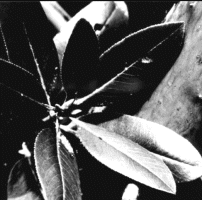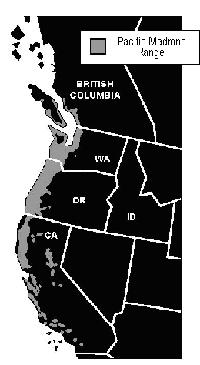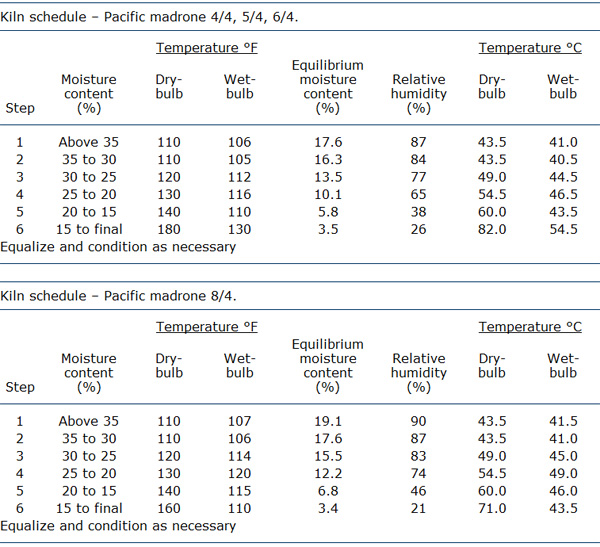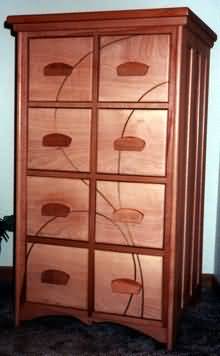 madrone, madroña, madroño
madrone, madroña, madroño
- General Characteristics
- Biology & Management
- Harvest & Utilization
- Wood Properties
- Related Literature
- Oregon Producers and Users of Pacific madrone
This information was originally published in Hardwoods of the Pacific Northwest, S.S. Niemiec, G.R. Ahrens, S. Willits, and D.E. Hibbs. 1995. Research Contribution 8. Oregon State University, Forest Research Laboratory
General Characteristics
Pacific madrone is one of the largest of about 14 species of Arbutus in the world, and one of the two Arbutus species in North America. Pacific madrone is a broadleaved evergreen tree and a member of the heath family (Ericaceae). It is distinguished by its smooth trunk, orange-red deciduous bark, white flowers, and red berries.
 Size, Longevity, and Form
Size, Longevity, and Form
Pacific madrones attain heights of 80 to 125 ft and diameters of 24 to 48 in. The largest trees may be as much as 400 years old; ages of 200 to 250 years have been counted. Pacific madrone can develop a clear, straight bole under good conditions in forest stands, particularly in canyons and dense stands. Open-grown individuals and trees growing on lower quality sites often have multiple stems, which originate from sprouts or root burls that often are J-shaped and forked. The tree may become shrubby on poor sites. Pacific madrone generally develops a deep and spreading system of lateral roots, often in association with large root burls. Seedlings have a tap root.
Geographic Range
Pacific madrone is found from San Diego (lat 33° N) to eastern Vancouver Island (lat 51° N). In Oregon and Washington, it is restricted to the Coast Range and the west slopes of the Cascade ranges. In California, it is also found in the Coast Range, throughout much of the Klamath Mountains, and in some areas west of the Sierra Nevada.
Timber Inventory
Pacific madrone is the most common abundant hardwood in the Siskiyou Mountains and interior coast ranges of the Southwest subregion of Oregon. This is the only subregion of Oregon that has a substantial inventory of Pacific madrone timber (Appendix 1, Table 1). Much of the Pacific madrone in Oregon is on federal lands, although volume estimates are not readily available. Pacific madrone is the second-most abundant hardwood in northern California. In Washington, it is common in the Puget Sound and Olympic subregions.
Biology and Management
Tolerance, Crown Position
Pacific madrone most commonly occurs as a codominant or intermediate tree in a canopy of mixed-hardwood species that often have some overstory of conifers. Pacific madrone is intermediate in tolerance. Tolerance appears to be lower for older trees and for trees at the northern end of the range. Seedlings establish best in partial shade, and young trees can survive in fairly dense shade. Top light is required for good growth; older trees may require top light to survive. Pacific madrone will grow toward openings, leaning as much as 15 to 20 degrees.
Ecological Role
Pacific madrone can be subclimax or climax in successional status; a substantial component of madrone is often maintained by periodic fires in the southern and central parts of its range. Although the thin-barked stems are easily killed by fire, Pacific madrone often dominates post-fire vegetation via vigorous regeneration of sprouts. It can also persist as a component of the mixed Douglas-fir/tanoak/Pacific madrone forest type.
Associated Vegetation
In the heart of its range, Pacific madrone is a major component of a widespread mixed-evergreen forest, which is characterized by an overstory of Douglas-fir and a secondary canopy of mixed hardwoods. Understory vegetation is often sparse under mature stands containing Pacific madrone. Pacific madrone is a common associate in a variety of other major cover types in the region.
Common tree species associated with Pacific madrone include Douglas-fir, ponderosa pine, sugar pine, white fir, western hemlock, tanoak, Oregon white oak, California black oak, giant chinkapin, bigleaf maple, bitter cherry, and California-laurel. Small trees commonly associated with Pacific madrone include vine maple, black hawthorn, red osier dogwood, willow, hazel, and red elderberry. Numerous shrub associates include manzanitas, Oregon-grape, ceanothus, salal, oceanspray, poison-oak, gooseberry, wood rose, snowberry, huckleberry, and thimbleberry.
Suitability and Productivity of Sites
Pacific madrone is particularly suited for warm, dry sites in the Northwest, especially on south and west aspects. Many of these sites may be marginal for production of other tree species, particularly in the absence of intensive vegetation management. On such sites, Pacific madrone’s ability to maintain forest cover and produce usable wood becomes an important asset, one that may be improved with management. Relatively good growth and stem quality can be produced on better sites, although species such as Douglas-fir and tanoak are also more competitive on these sites. There are no established guides or site-index curves for estimating the productivity of a site for Pacific madrone. A site with good potential for growth of Pacific madrone is indicated by site trees with the following characteristics:
- Top height on mature trees of 80 to 100 ft
- Rapid juvenile height growth of 1 to 3 ft per year
- Sustained height growth from age 15 to 30 of 1 to 2 ft per year
- Continuing diameter growth on mature trees.
Climate
Pacific madrone prefers a climate characterized by mild, wet winters and dry, cool summers. Within its range, annual precipitation varies from 25 to 118 in. and average temperatures range from 36° F in January to 77° F in July.
Pacific madrone tolerates warm, dry conditions better than most tree species in the Northwest. It is one of the most drought-tolerant trees in the region and it has superior ability to extract water from soil or rock. Its roots can penetrate up to 12 ft in fractured bedrock, giving it access to substantial moisture unavailable to shallow-rooted species. Established and resprouting Pacific madrone are thus able to maintain relatively good growth on shallow, rocky soils where it may be difficult for seedlings of any species to establish and grow.
Pacific madrone is relatively sensitive to cold and snow. Its broad, evergreen leaves and brittle branches are vulnerable to breakage from heavy wet snow. Foliar damage and die-back are commonly observed after severe freezing or unseasonable frost. At the northern end of its range, Pacific madrone is one of the least frost-resistant tree species.
Pacific madrones are relatively windfirm because of their deep, spreading root systems.
Elevation
At the southern end of its range, Pacific madrone is found from 2000 to 4260 ft in elevation. In the north, it ranges from sea level to 3000 ft.
Soils
Towards the southern and middle part of its range, Pacific madrone grows on soils derived from a wide variety of parent materials. In the north, it is usually found on soils derived from glacial sands and gravels or hard glacial till. It is often found on rocky soils and on soils with low moisture retention. Pacific madrone is generally restricted to soils with good internal drainage; it will not tolerate poor soil drainage or flooding.
Flowering & Fruiting
Pacific madrone produces seed as early as 3 to 5 years of age. Trees begin flowering in early spring, from mid-March to May, depending on the elevation. The blossoms are dense, drooping clusters (terminal panicles) of small, white, urn-shaped flowers. The fruit is a berry (0.3 to 0.5 in.), which ripens in the fall, turning from yellow-green to bright red or reddish-orange.
Seed
Berries number from 630 to 1130/lb and contain an average of about 20 seeds per berry. Seeds are small, numbering from 197,000 to 320,000/lb. The berries are fleshy and relatively heavy; the seed are thus dispersed by gravity or by animals. The berries are eaten by many birds and mammals.
To obtain seeds, berries should be collected soon after they ripen in the fall. The following methods have been suggested for treatment of berries and seeds (Jane Smith, USDA Forest Service, PNW Station, Corvallis, Oregon). Berries can be dried at room temperature and stored at 34°F (4°C) for at least 2 years. Seeds should be separated from the pulp of fresh or dried berries. To extract seeds from dried berries, berries can be soaked in water (overnight) and blended in cold water in a blender at low speed for 3 to 10 minutes. Moist stratification for at least 4 to 6 weeks at 1 to 2°C may improve germination.
Regeneration from Seed
In the northern parts of its range, Pacific madrone usually produces seed every year. Very good crops may occur as frequently as every 2 years, while very light seed crops may occur only once in 10 years. At the southern end of its range, good seed crops may occur as infrequently as once every 10 years. Seeds usually germinate in the first year after ripening. Natural rates of survival are often very low (0 to 10 percent) after seedling emergence because of drought, fungi, or predation.
Seedlings of Pacific madrone establish naturally in disturbed soils along roads, near uprooted trees, or in partially open forests. Bare mineral soil provides the best seedbed; very few seedlings establish in undisturbed litter. Seedlings also need partial shade to establish. Early growth of seedlings under natural conditions is slow (2 to 4 in. per year).
Regeneration from Vegetative Sprouts
Most reproduction of Pacific madrone arises from sprouts after fire or cutting. Death of the main stem stimulates profuse sprouting (up to 300 sprouts per parent), which originate from dormant buds near the root collar. These sprouts provide reliable regeneration and have rapid growth potential, which is due to carbohydrate reserves and soil access provided by pre-existing roots. Sprouts may grow as much as 5 ft in height the first year and attain an average height of 10 ft after 3 years. To produce vigorous, high-quality sprouts, stumps should be cut low to the ground (<8 in.), with a slight angle to the stump surface. Pacific madrone sprouts in partial or shelterwood cuttings have relatively poor growth and quality. Moderate to large clearings with little competitive vegetation produce the best growth of sprouts.
Regeneration from Planting
Little effort has been made to regenerate Pacific madrone from planted seedlings. Commercial seedling production methods have not been developed, although good quality seedlings have been produced for some research applications. Mortality rates have been high in field transplantings to date.
Site Preparation and Vegetative Management
Little site preparation is necessary for establishing stands of sprout origin. Regeneration and growth may be enhanced by burning or mechanically removing slash that shades Pacific madrone stumps. Rapid growth of sprout clumps makes Pacific madrone a superior competitor in the new stand. Control of competing herbs and shrubs can greatly improve the growth of young sprouts.
Site-preparation treatments that produce bare mineral soil while leaving some partial shade (debris, vegetation) may be best for promoting establishment and growth of Pacific madrone seedlings.
Stand Management
The growth and quality of Pacific madrone stands may be greatly improved through management. Diameter growth of madrone is responsive to increased growing space within or between sprout clumps.
Sprouts should be thinned after dominant stems have emerged, at 5 to 10 years. Thinning should select well-formed, dominant stems that originate near the ground and are evenly distributed around the stump. One early thinning is probably adequate for production of firewood, which may be done in 15- to 20-year rotations. A second thinning (yielding firewood) may be beneficial if sawtimber production is desired.
Thinning in older existing stands can increase diameter growth on residual trees by 2 to 5 times. Pacific madrone stands (pure or mixed) are often quite dense, and sometimes stagnant, with little or no diameter growth. Periodic thinning may be necessary to avoid stagnation and maintain stand growth.
Selective harvesting or dense shelterwoods are not recommended for management of Pacific madrone sprouts. Uneven-aged management may be feasible over a large area, with clearing in patches larger than 0.2 acres. Thinning will be necessary within patches or sprout clumps.
Mixed-species Stands
Pacific madrone typically occurs as a component or patch within mixed stands. Management of mixed stands is complex, and may require periodic treatments to maintain growth of diverse components. Pacific madrone stump sprouts may need to be controlled or thinned to avoid early suppression of associated conifer seedlings. Later treatments may be needed to maintain growth of Pacific madrone, particularly on better sites where conifer species are superior competitors.
Growth and Yield
Most natural Pacific madrone stands originate from sprouts. Dense sprout regeneration grows rapidly under open conditions. By age 10, the average height of sprouts may reach 15 to 22 ft and stand basal area may reach 100 ft2 per acre on a good site. Typical mature trees (50 to 70 years old) are 50 to 80 ft tall and 10 to 20 in. in diameter. Diameter growth in natural stands is relatively slow, averaging 12 to 15 rings per in.
Mature stands or patches may attain basal areas of 140 to 200 ft2 per acre. The best stands of Pacific madrone may exceed 4000 ft3 per acre over several acres. Average stand volume of Pacific madrone forest types in California is 1705 ft3 per acre.
There are few examples of growth and yield from managed stands. One test with 45-year-old Pacific madrone on a poor site suggested that thinning in dense, stagnant stands can greatly increase diameter growth (as much as 5 times) while maintaining or even increasing total annual volume growth per acre (33 to 37 ft) after removal of up to 65 percent of the stand basal area. Another study of Pacific madrone in mixed hardwood stands in northern California showed annual growth rates of 85 ft3 per acre among all species combined, after removal of 40 to 50 percent of the original stand basal area.
Interactions with Wildlife
Pacific madrone berries are an important food for many birds and mammals. The berries are a particularly significant component in the diet of doves and pigeons during the fall. Deer eat the berries and also browse young shoots. Damage caused by animals is relatively minor on Pacific madrone. Live trees with rotten heartwood provide excellent habitat for cavity-nesting birds. Pacific madrones in mixed-conifer forests provide a middle canopy story, an important element in forest structural diversity.
Insects and Diseases
Significant mortality and damage is caused by a fungus commonly known as “madrone canker” (asexual stage, Fusicoccum aesculi; sexual stage Botryosphaeria dothidea). The canker causes a dieback of branches from the tip, and cankers may spread to the bole and kill the tree. The bark of dead branches becomes blackened, somewhat resembling fire damage. The disease reproduces from spores in the outer bark, which are spread by insects and, possibly, rain and wind.
A basal canker, Phytophthora cactorum, also has significant impact. The annosus root rot, Heterobasidium annosum, has potential to cause serious damage.
Insects such as defoliators, wood borers, and bark beetles are common but cause only minor damage.
Genetics
No natural varieties or hybrids of Pacific madrone are recognized, although there may be some horticultural cultivars.
Harvesting and Utilization
Cruising and Harvesting
Diameter at breast height and total height of Pacific madrone can be used in tables or equations to estimate total tree volume in cubic feet and sawlog volume. Tests of the eastern hardwood grades have found no difference in value between log grades for this species, but have found a significant relation between log diameter and value. Stump burls offer an additional harvesting and management option for Pacific madrone.
Product Recovery
Sawlogs usually have a minimum small-end diameter of 10 in.; smaller logs are chipped for pulp. The percentage of No. 1 Common and Better green lumber recovered from Pacific madrone logs compares favorably with the grade recovery from eastern oaks (Appendix 1, Table 2). Pacific madrone burls are highly prized and valued for their appearance, and are used in novelty items such as tables and clocks.
Wood Properties
Characteristics
Pacific madrone is a hard, heavy wood with a fine grain and little texture. The sapwood is white or cream-colored with a pinkish tinge; the heartwood is a light reddish-brown. The wood is without any characteristic odor or taste. Pacific madrone wood is diffuse porous; the pores are nearly uniform, numerous, and minute. With a hand lens, the growth rings are barely visible. The rays range from barely visible to readily visible.
Weight
Pacific madrone weighs about 60 lb/ft3 when green and 45 lb/ft3 at 12 percent MC. The average specific gravity is 0.58 for green volume and 0.69 for ovendry.
Mechanical Properties
Pacific madrone wood has good strength properties. For most of its common applications (e.g., flooring or furniture), its resistance to indentation and abrasion is a plus. Pacific madrone has exceptional resistance to breakage, making it suitable for joinery. Because of its hardness, nailing is difficult and splitting is likely unless the wood is prebored. See Appendix 1, Table 3 for average mechanical properties for small, clear specimens.
Drying and Shrinkage
Pacific madrone requires special care during drying because of its wetwood, which can contribute to collapse. Green MC for this wood ranges from 68 to 93 percent. Its shrinkage values are considerably higher than for most other woods, which may result in increased drying degrade from warp. The radial shrinkage (green to ovendry) is 5.4 percent and the tangential shrinkage is 11.9 percent. For comparison, the respective values for alder are 4.4 percent and 7.3 percent, and for white oak are 4.2 percent and 9.0 percent. Lumber cut in a quartersawn pattern will minimize some of the high shrink/warp potential; otherwise, careful design consideration is a must. Because the tree does not always grow straight, tension wood sometimes forms, which will contribute to nonuniform shrinkage. Presteaming the kiln charge and stickering at a closer interval has been used successfully to control warp. (See the tables below for the appropriate kiln schedules).
Prior to kiln drying, Pacific madrone can develop a chemical oxidative stain that appears as blue or purple streaking in the wood. It does not show on rough-sawn surfaces of the wood and is apparent only after planing. To minimize staining, madrone should be dried as soon as possible after sawmilling, and tight stacking of wet lumber should be avoided.

 Machining
Machining
Of all the hardwoods of the Pacific Northwest, Pacific madrone ranks highest (fewest machining defects) for planing, shaping, boring, and turning. Because of its high density, it should not be processed too fast (overfeed). It is recommended that saws and other tooling have a hook angle of 20° and a sharpness angle of 55° for optimum performance. As with other fine-grain, hard woods such as birch or maple, surface scratching (cross-grain or swirls) during sanding can be a problem with Pacific madrone.
Adhesives
Pacific madrone bonds well; there are no unusual problems with this wood when gluing conditions are moderately well controlled. Careful curing/drying of glue joints is required to prevent sunken gluelines from subsequent machining.
Finishing
Pacific madrone finishes well, without the need to fill the grain; it colors best with dyes or transparent stains. Heavily pigmented stains tend to be muddy in appearance. Pacific madrone can be successfully ebonized.
Durability
Pacific madrone is a nondurable species that is susceptible to wood decay. Untreated wood posts in ground contact have an average service life of 6 years. Mold and oxidative staining are moderate problems.
Uses
Pacific madrone is used for furniture, flooring, turnings, paneling, veneer for hardwood plywood faces and core stock, pulpwood, and firewood.
Related Literature
DICKINSON, F.E., D.R. PRESTEMON, and W.A. DOST. 1965. Pacific madrone log grades and lumber yield. California Agriculture Experiment Station, Berkeley, California California Forestry and Forest Products No. 43.
McDONALD, P.M. 1983. Local volume tables for Pacific madrone, tanoak, and California black oak in north-central California. USDA Forest Service, Pacific Southwest Forest and Range Experiment Station, Berkeley, California. Research Note PSW-362. 6 p.
McDONALD, P.M. 1992. Estimating seed crops of conifer and hardwood species. Canadian Journal of Forest Research 22:832-838.
McDONALD, P.M., D. MINORE, and T. ATZET. 1983. Southwestern Oregon-northern California hardwoods. P. 29-32 in Silvicultural Systems for the Major Forest Types of the United States. R. Burns, tech compil. USDA Forest Service, Washington, DC. Agriculture Handbook 445.
McDONALD, P.M., and J.C. TAPPEINER II. 1990. Pacific madrone. P. 124-132 in Silvics of North America. Volume 2, Hardwoods. R.M. Burns and B.H. Honkala, coords. USDA Forest Service, Washington D.C. Agriculture Handbook 654.
RAPHAEL, M.G. 1987. Use of Pacific madrone by cavity-nesting birds. P. 198-202 in Proceedings of the Symposium on Multiple-Use Management of California’s Hardwood Resources. T.R. Plumb and N.H. Pillsbury, tech. coords. USDA Forest Service, Pacific Southwest Forest and Range Experiment Station, Berkeley, California. General Technical Report PSW-100.
TAPPEINER, J.C., II, P.M. McDONALD, and T.F. HUGHES. 1986. Survival of tanoak (Lithocarpus densiflorus) and Pacific madrone (Arbutus menziesii) seedlings in forests of southwestern Oregon. New Forests 1:43-55.
TINNIN, R.O., and L.A. KIRKPATRICK. 1985. The allelopathic influence of broadleaf trees and shrubs on seedlings of Douglas-fir. Forest Science 31:945-952.
ZUMRAWI, A.A., and D.W. HANN. 1989. Equations for predicting the height to crown base of six tree species in the central western Willamette Valley of Oregon. Forest Research Laboratory, Oregon State University, Corvallis. Research Paper 52. 12 p.
